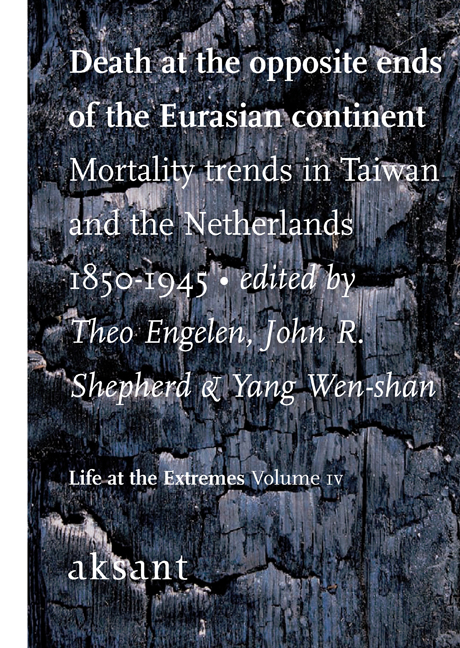 Death at the Opposite Ends of the Eurasian Continent
Death at the Opposite Ends of the Eurasian Continent Book contents
- Frontmatter
- Contents
- Introduction: Death at the Opposite Ends of the Eurasian Continent: Mortality Trends in Taiwan and the Netherlands, 1850-1945
- 1 Trends in Mortality and the Evolution of the Cause-of-death Pattern in the Netherlands: 1850-2000
- 2 Trends in Mortality and Causes of Death in Japanese Colonial Period Taiwan
- 3 Mortality in the Netherlands: General Development and Regional Differences
- 4 Regional and Ethnic Variation in Mortality in Japanese Colonial Period Taiwan
- 5 An Outline of Socio-medical Care in the Netherlands, 19th and Early 20th Centuries
- 6 An Overview of Public Health Development in Japan-ruled Taiwan
- 7 The Demographic History of Smallpox in the Netherlands, 18th-19th Centuries
- 8 Anti-malaria Policy in Colonial Taiwan
- 9 Maternal Mortality in Taiwan and the Netherlands, 1850-1945
- 10 Maternal Depletion and Infant Mortality
- 11 The Massacre of the Innocents: Infant Mortality in Lugang (Taiwan) and Nijmegen (the Netherlands)
- 12 Illegitimacy, Adoption, and Mortality Among Girls in Penghu, 1906-1945
- 13 How Reliable is Taiwan's Colonial Period Demographic Data?: An Empirical Study Using Demographic Indirect Estimation Techniques
- References
10 - Maternal Depletion and Infant Mortality
Published online by Cambridge University Press: 22 January 2021
- Frontmatter
- Contents
- Introduction: Death at the Opposite Ends of the Eurasian Continent: Mortality Trends in Taiwan and the Netherlands, 1850-1945
- 1 Trends in Mortality and the Evolution of the Cause-of-death Pattern in the Netherlands: 1850-2000
- 2 Trends in Mortality and Causes of Death in Japanese Colonial Period Taiwan
- 3 Mortality in the Netherlands: General Development and Regional Differences
- 4 Regional and Ethnic Variation in Mortality in Japanese Colonial Period Taiwan
- 5 An Outline of Socio-medical Care in the Netherlands, 19th and Early 20th Centuries
- 6 An Overview of Public Health Development in Japan-ruled Taiwan
- 7 The Demographic History of Smallpox in the Netherlands, 18th-19th Centuries
- 8 Anti-malaria Policy in Colonial Taiwan
- 9 Maternal Mortality in Taiwan and the Netherlands, 1850-1945
- 10 Maternal Depletion and Infant Mortality
- 11 The Massacre of the Innocents: Infant Mortality in Lugang (Taiwan) and Nijmegen (the Netherlands)
- 12 Illegitimacy, Adoption, and Mortality Among Girls in Penghu, 1906-1945
- 13 How Reliable is Taiwan's Colonial Period Demographic Data?: An Empirical Study Using Demographic Indirect Estimation Techniques
- References
Summary
Maternal depletion refers to the possibility of ongoing decline in physical health during the reproductive life of a woman. It is the result of the growing metabolic burden of successive gestations and periods of lactation in societies where birth intervals are short. Especially when food is in short supply mothers will not be able to recover from a previous pregnancy before the next starts. Thus, depletion is a threat for all women experiencing short intervals between births. It is an even more serious threat for women growing older, since their recuperation takes longer (Wood 1994; Ellison 2001).This phenomenon has many implications for the women themselves and for their fecundity. In this paper we are interested in one specific implication: infants of depleted mothers run a higher risk of dying. Ellison specifically points out: “The shorter the interval separating births, the greater the risk of mortality of the offspring. Intervals of less than two years between births are particularly dangerous,” (Ellison 2001: 95-97).
Ellison's observation is not new. One of the well-known predictors for infant mortality is the length of the preceding birth interval. Studies of populations in different parts of the world and in different time periods have come to the general conclusion that inter-pregnancy intervals shorter than 18 months, in some cases shorter than 24 months, have a negative effect on the survival chances of children closing this interval (De Sweemer 1984; Conde-Agudelo 2006).
The causal link with infant mortality is through birth weight. Children born less than two years after the previous birth have a lower birth weight, their general condition is more likely to be frail, and, thus, their chances of reaching their first birthday relatively low (De Sweemer 1984: 50). All things being equal we expect this phenomenon to be visible in all societies. By definition, however, all things are not equal. Since we compare in this paper a Western European and a Chinese population we are dealing with societies that, for those who believe the observations by Thomas Malthus, regulated population growth via a preventive and a positive check, respectively. The preventive check used marriage restriction to limit the number of women marrying and to keep the age at marriage high.
- Type
- Chapter
- Information
- Death at the Opposite Ends of the Eurasian ContinentMortality Trends in Taiwan and the Netherlands 1850–1945, pp. 275 - 288Publisher: Amsterdam University PressPrint publication year: 2012


